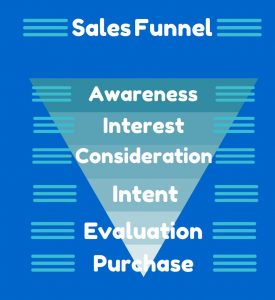4 Key Steps To Develop Sales Funnels
If you’re selling a product or service, you probably have a sales funnel strategy. It’s the journey that you guide a prospect through as they first discover your product or service to the point of them buying and becoming a repeat customer.
As visitors move along your funnels – from knowing more about your brand, to deciding if they need what you’re offering, to comparing with similar competitors, to making the final or even repeat purchase, you need to know how to respond to their needs and doubts.
Therefore, you need to regularly analyze, improve and develop sales funnels to keep the pipeline flowing. Here’s how to optimize your funnels for better conversions in 4 key steps.
FREE Checklist: Create An Effective Sales Funnel
1. Build Google Analytics Funnels

The first step to optimizing your funnels for better conversion is stepping up funnel visualization with Google Analytics. Do you have Google Analytics yet? If not, it’s time to set it up.
Google Analytics can help you develop sales funnels to be more effective. It will help you collect data, which in turn will help you know when and where prospects and leads are abandoning your conversion funnels.
For instance, you may see that people are missing out one page in your sales funnel template, and this is the page where you have listed the prices. Knowing this, you can improve conversions by moving prices up the sales path. Also, test to see if adding trust elements on that page helps.
2. Analyze Your Landing Pages
Your landing page is the page on your website where the awareness and interest elements of your sales funnel begins. It’s important to be clear on the objective of your landing page. What do you want visitors to do? For example, do you want them to explore more of your website, click through to a sales page or opt-in to your email list? Here are the elements to focus on:
- Headlines: Test different headlines to see which ones attract and convert more visitors.
- Copy: Your copy should offer visitors clear benefits. Start with your most promising benefits to keep readers engaged and to persuade them to take action.
- Colour: Test different text colours and backgrounds to see what performs better. This will help you come up with a colour scheme that generates more conversions.
- Font size: Test different font sizes to see which size keeps readers on your page longer. Also, try different font styles to see how they influence conversion.
- Purchase Path: Analyze your purchase path and remove any friction you uncover. Remember, low loading speed could be the biggest hindrance to your conversion rate. Use Google’s Page Speed Report to optimize your funnels. This may also help you see the impact of slow page load on conversion.
3. Define Customer Next Steps Using Call-to-Actions
Be short and elaborate with your Call-to-Actions (CTAs). You can use these low-threat CTAs to improve your conversion. For example, use words like, receive, get, enjoy, view, discover, see, play, and claim.
People don’t like doing work, particularly for things they aren’t sure they want. So, make it easy for them and assure them you’re doing the heavy lifting to make sure they have a simple and pleasant experience. To optimize your sales funnels for more conversions, keep your CTAs above the fold for better visibility. This could increase the number of people who see your CTA. Also, add a CTA that pops up to grab your visitors’ attention when they try to leave your funnel.
Use one CTA for each landing page, to avoid confusing visitors about what steps to take next. Test different wording on your CTA, and test the number of CTA buttons on the landing page to see what works better. This is vital because you can improve your conversion rates by 30% or more by testing your CTA headlines.
4. Analyze Your Trust Elements
Trust on the internet is a huge thing, especially if you’re trying to get people to give you their hard-earned money. It’s therefore crucial to build trust into your landing page and throughout your online funnels.
You can use these elements to gain trust:
- Guarantee: Will you refund their money if they aren’t satisfied with what they get? Will you do this in 30 days, 60 days, or 90 days? Try different variations to see what performs better.
- Better Business Bureau Logo: While you may have to pay about $400/year to get the BBB logo, it is worth it because it puts your customers at ease.
- Secure Socket Layer (SSL) Certificate: The ‘https:’ before your domain name shows your audience that your site is secure. Plus, it’s important for Google search to offer that option so that your website shows up as secure and that Google lists your site in the search results.
Do a few rounds of A/B testing and experiment to see which logo leads to more conversions. It’s vital to find the perfect position for each trust elements on your site.
Free Checklist: How To Develop Sales Funnels For Beginners
If you want to optimize your funnels and generate more conversions, make sure you test your funnels regularly. This will help you gather a lot of actionable data, which can help you improve your conversion rates. If you’re not analyzing your funnels, you’re leaving your money on the table. And as you can see from the points above there are a number of inexpensive ways to analyze and optimize your funnels.
When you develop sales funnels the right way, it puts your business on autopilot and consistently turns prospects into paying customers. To learn how to build a sales funnel from scratch download my free Sales Funnel Checklist and use your funnels to get your business from unsuccessful and unprofitable to profitable success.
